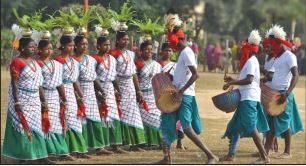Adivasi Divas is a regional public holiday observed every year on August 9. It coincides with the International Day of the World’s Indigenous Peoples, declared by the United Nations in 1993. ‘Adivasi’ refers to various tribes living in the Indian subcontinent, while ‘Divas’ means ‘day’ in Hindi. Despite several advancements in modern society, indigenous people are often among the poorest ethnic groups. Adivasi Divas seeks to recognize the challenges these people continue to face today, as well as honor their
perseverance and struggle for improvement. Around 104 million people (over 9% of India’s population) fall into this category.
HISTORY OF ADIVASI DIVAS
The Adivasi are the indigenous tribes of the Indian subcontinent. People from these tribes live as foragers or as tribalistic sedentary communities, primarily in India. The term also refers to ethnic minorities in the neighboring countries of Bangladesh, Nepal, and Sri Lanka. But India does not recognize tribes as indigenous people. These tribes are considered to be the original inhabitants of India, before the Dravidian and Indo-Aryan people. However, many present-day Adivasi communities were formed after the decline of the Indus Valley Civilization. Although the Adivasis are considered socially and economically backward, they often enjoyed autonomy and evolved mixed hunter-gatherer and farming economies in ancient and medieval India. In some areas, securing Adivasi approval and support was considered important by local rulers. Larger Adivasi groups sustained their kingdoms in central India. The Meenas and Gond Rajas of Garha-Mandla and Chanda formed a kind of Adivasi aristocracy. These relations soured during the Mughal rule in India, where many of them were killed in wars between the two tribes. Under British rule, the colonial administration also encroached upon the tribal system, leading to the tribes resenting and rebelling against the British. Rising feudalism in India under British rule also worsened their relations and contributed to the social and economic devolution of the tribes. Forest, as well as farmland belonging to the tribes, was taken by the British who instead of helping the communities, imposed taxes on them. When the tribes were unable to pay, they were coerced into bonded labor.
On being exposed to common infectious diseases from Eurasia, the isolated tribes of the South Andaman Island were badly affected and experienced a huge population decline in 1789.











More Stories
Kajol & Rani Mukherji get emotional during family Durga Puja celebrations
PM Modi meets Vice President CP Radhakrishnan in Delhi
21st Annual Convocation of KIIT-DU Begins Tomorrow